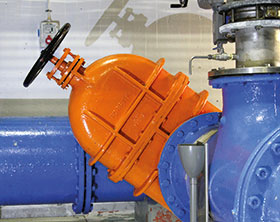

Getting valves and flowmeters to work together is sometimes a challenging task within industrial water and wastewater applications. Valves tend to create the kind of irregular media flow patterns in pipelines that make it a challenge to achieve accurate flow measurement of liquids, gas or steam. That is why many types of popular liquid flowmeters require straight pipe runs. Unfortunately, the nature of the process or the kind of space required for long straight runs of pipe is often an impossible luxury in many of today’s plants.
How valves create flow disturbances
Depending on a pipeline’s flowing media (liquid, gas or steam), the process pressures and the process temperatures, the fluid flow dynamics within a pipeline can vary widely. The ideal pipeline configuration for the accurate measurement of flow with nearly all of the industry’s most popular flow sensors is a straight pipe with consistent media conditions Many processes by their very nature, however, tend to be unstable and create irregular flows within a pipeline all by themselves.
Plant layouts, especially expansions and retrofits, also tend to create less than optimum pipeline conditions for the measurement of flow. The addition of valves, pumps, elbows and other equipment into the pipeline create media swirling and other effects that can result in irregular flow profiles that will reduce meter measurement accuracy and repeatability. That is why many flowmeter manufacturers recommend anywhere from 5 to 10 pipe diameters of straight pipe run upstream and downstream of the flowmeter – depending on the flow sensing technology in use.
Flow straightening and conditioning
While the simple solution is to know your flowmeter and its straight pipe run requirements to achieve accurate, consistent measurement, this is often easier said than done. Today’s complex and ever changing industrial processes, the need to treat and conserve water, crowded plant environments where real estate is precious, regulatory requirements and the team involved in running any plant can mean that your valve or elbow inevitably intrudes on your flowmeter’s turf. Many times the first sign of the problem is when the flowmeter is not reading the flow accurately. By then changing the pipeline layout or moving other devices such as valves is impractical and too costly.
Flow straighteners and conditioners offer an answer to this problem. There are several different types of flow straighteners and conditioners, including perforated plates, tube bundles, etc. The purpose of all flow straighteners and conditioners is to eliminate swirl and provide a stable velocity flow profile. Of course the ideal time to think about flow conditioning is before the flowmeter is installed so that the two can be calibrated to work together. One drawback to add-on flow conditioners and straighteners is that they increase head loss.
Flowmeters with built-in conditioning
Another solution to consider is the installation of a flowmeter with built-in flow conditioning. This type of solution offers the advantages of installation flexibility, reduced equipment, simplified installation with potentially fewer pipe penetrations and reduced maintenance requirements. Several manufacturers offer flowmeters that include built-in flow conditioning. For example, McCrometer’s V-Cone flowmeter is a differential pressure sensing device with integral flow conditioning that operates within liquids, gas or steam.
The V-Cone’s DP flow sensor conditions fluid flow to provide a stable flow profile that increases accuracy. The flow sensor’s design features a centrally located cone inside a tube. The cone interacts with the fluid flow and reshapes the velocity profile to create a lower pressure region immediately downstream. The pressure difference, which is exhibited between the static line pressure and the low pressure created downstream of the cone, can be measured via two pressure sensing taps. One tap is placed upstream of the cone and the other is located in the downstream face of the cone itself. The pressure difference can then be incorporated into a derivation of the Bernoulli equation to determine the fluid flow rate.
The cone’s central position in the line optimises the velocity of the liquid flow at the point of measurement. It forms very short vortices as the flow passes the cone, which create a low amplitude, high frequency signal with excellent stability. The result is a highly stable flow profile for measurement accuracy to 0,5% with +0,1% repeatability over a wide flow range of 10:1. All of this is possible with a minimal straight pipe run of 0 to 3 diameters upstream and 0 to 1 diameters downstream from the meter depending upon placement from valves and other control devices.
Conclusions
Getting accurate flow measurement with valves, pumps, and other equipment in relatively close proximity is difficult, but achievable. The ideal way to achieve accurate and repeatable flow measurement within industrial water and wastewater applications is to recognise in advance the straight pipe run requirements of the flow sensing technology in use at your plant. When the process, the plant layout or other factors lead to swirl in your pipeline that affects meter performance, then consider either flow conditioners or a flowmeter with built-in flow conditioning.
For more information contact Stuart Brown, UIC Instrumentation, +27 (0)31 468 2561, [email protected], www.uic.co.za
| Tel: | +27 31 468 2561 |
| Email: | [email protected] |
| www: | |
| Articles: | More information and articles about UIC Control & Automation |

© Technews Publishing (Pty) Ltd | All Rights Reserved